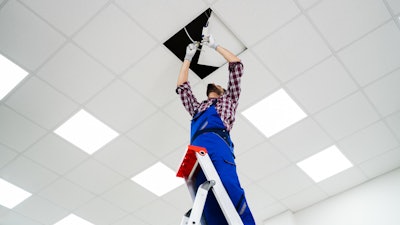
Light-emitting diodes (more commonly known as LEDs) are the new era of electronics that have replaced incandescent lights. They are 90% more effective than traditional lights and can come in unique and variable designs due to their tiny structure.
LEDs work by lightening up when an electrical current passes through a microchip present within the LED that produces visible light. They are also equipped with proper thermal control. They have a heat pocket that absorbs any heat produced by the LED.
However, LEDs have a very specific mechanism, and they need the right power supply to function effectively. Depending on the device the LED is placed into, the amount of voltage required for full intensity will differ. The voltage supplied to the LED must always be greater than the diodes forward drop voltage. This article will guide you on how to choose the correct supply power.
Selecting the Desirable Power Source
If you are trying to select a power supply for an LED Light application, you must consider a lot of factors. Firstly, think about where you will be placing this light and the environment around it. For instance, will it be placed outdoors or indoors? If it is placed outdoors, will the power supply have to be water-proof? Don’t forget to think about convection and conduction cooling of the power supply.
The environment is a big factor in such cases. It can change the way energy is consumed, and hence you need to really figure out the proper amount of wattage your LED light will use to avoid any energy loss.
Determining the Correct Amount of Wattage
Knowing how many watts are required by your light source is the most crucial bit. It will be contingent on the number of bulbs or light applications you plan to connect to one power supply. You can either calculate it yourself or get your technician to do it (which would be a better option). Always keep a 20% safety cushion on the overall wattage you have calculated.
This can be done by figuring out a power supply rated for a wattage that is equal to the total wattage needed by the LEDs multiplied by 1.2. For instance, you have a project that contains 3 runs of LED strips (each requiring a power of 9 watts). The total power supply would be 27 WATT. If we simply multiply 27 by 1.2, we get the 20% cushion of 32.4 WATT; so using a 40-Watt or greater power supply will meet your project’s requirements.
Maintenance and Regulation
Regulation is one thing that should be focused on once the power supply has been chosen and the overall system wattage calculated. You will need to think about the area you live in and the kind of utilities offered there. There are safety standards and harmonic current limits that need to be thought about.
You also need to know if your LED will work well using an ITE power supply and how effective any power supply you use needs to be in order to suffice the local and regional standards.
The Voltage of your LED
As you start working on your LED project or attempt to fix a faulty power supply, make sure to see if the voltage being supplied is compatible with the LED’s voltage. When you buy an LED product, always check for products with built-in current regulators as they come with specific voltage measurements.
While selecting a power supply for your LED strips, bulbs, or applicators, be sure to check if it can handle the input voltage supply. It all depends on your location; line voltage varies based on the country you live in. A good approach will be to know if you have a low line AC power or a high line AC power. That will help you figure out if your power supply is well-matched with the line power of your area.
Line voltages may fluctuate, which can be dangerous at times, which is also a good reason to have that 20% cushion in your wattage that we talked about earlier.
The Ecological Conditions
Climate change is a rising concern this year. This proves that weather conditions can affect just about anything, including LED lights. This is the one thing that is commonly neglected while choosing a power supply. Just like enzymes have optimums, power supplies have temperature parameters where they work at utmost efficacy. So don’t simply place your power supply where it can heat up, crossing this temperature range and causing a dangerous disaster.
On the contrary, don’t keep your power supply in a cold area as your power supply might literally be jammed due to cold, just like how our bones refuse to work during winter. Keep an eye on the IP rating, which will give you information about the maximum size of solid and pressure of liquid a power supply can repel.
It is usually a two-digit number where the first number is used to describe the size of the solid the power supply can withstand, whereas the second number represents the amount of liquid. The bigger these numbers are, the more protection your power supply will provide. With the increase of the first number, you can safely state that particles as small as dust won’t bring any harm, while with the increase in the second number, you can say that the power supply will be protected from light showers as well as heavier rain.
You Can Now Choose a Proper Power Supply For Your LED Application.
Choosing the correct power supply is essential in order to make your LED project work smoothly. Hopefully, by keeping all these points mentioned above in mind, you will achieve success in selecting the right power supply for your project.























